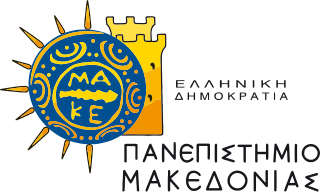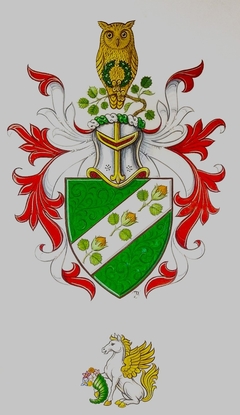
The University of Tartu is a public research university located in the city of Tartu, Estonia. It is the national university of Estonia. It is the biggest and oldest university in the country. The university was founded under the name of Academia Gustaviana in 1632 by Baron Johan Skytte, the Governor-General of Swedish Livonia, Ingria, and Karelia, with the required ratification provided by King Gustavus Adolphus, shortly before the king's death on 6 November in the Battle of Lützen (1632).

Established in 1918, Tallinn University of Technology is the only technical university in Estonia. TalTech, in the capital city of Tallinn, is a university for engineering, business, public administration and maritime affairs. TalTech has colleges in Tartu and Kohtla-Järve. Despite the similar names, Tallinn University and Tallinn University of Technology are separate institutions.

The University of Macedonia is a public research university in Thessaloniki, Macedonia, Greece. It is a modern institution, renowned for the quality, freedom, democracy, meritocracy and individual development it provides to its members.

An art school is an educational institution with a primary focus on the visual arts, including fine art – especially illustration, painting, photography, sculpture, and graphic design. Art schools can offer elementary, secondary, post-secondary, or undergraduate programs, and can also offer a broad-based range of programs. There have been six major periods of art school curricula, and each one has had its own hand in developing modern institutions worldwide throughout all levels of education. Art schools also teach a variety of non-academic skills to many students.
Çanakkale Onsekiz Mart University is a Turkish public research university located in Çanakkale (Dardannelles) province and its surrounding towns. It is a member of the Balkan Universities Network, the European University Association (EUA), International Association of Universities (IAU), and the Thrace Universities Union. It hosted the World Universities Congress in 2010.
Tallinn University is a public research university in Estonia. Located in the centre of Tallinn, the capital city of Estonia, Tallinn University is one of the three largest institutions of higher education in the country. Both QS World University and Times Higher Education rankings place it among the top 1000 universities in the world.

Swansea Metropolitan University is a former university based in Swansea, Wales, UK. The university merged with, and became a constituent campus of, the University of Wales Trinity Saint David on 1 August 2013.

The Estonian Academy of Music and Theatre began as a mixed choir of the Estonia Society Musical Department (EMD) on the eve of World War I. The assembly of the Estonia Society created the Tallinn Higher Music School on November 17, 1918. The opening ceremony took place on September 28, 1919. In 1923 the educational institution was renamed the Tallinn Conservatoire. In 1938 the State Drama School was opened. In 1993 the school was renamed the Estonian Academy of Music. In 1995 the Drama Faculty was renamed the Higher Theatre School.
The history of formal education in Estonia dates back to the 13–14th centuries when the first monastic and cathedral schools were founded. The first primer in the Estonian language was published in 1575. The oldest university is the University of Tartu which was established by the Swedish king Gustav II Adolf in 1632. In 1919, university courses were first taught in the Estonian language.

Istanbul Beykent University is a foundation university in Istanbul, Turkey, teaching in English, Russian combined and Turkish with 30.000 students.

Eugen Sterpu, is a Moldovan painter, as was his Estonian wife Viive Sterpu. Sterpu lives and works in Tallinn, Estonia.

Metropolia University of Applied Sciences is the largest University of Applied Sciences in Finland. The university has four fields of study: culture, business, health care and social services, and technology. Teaching is also provided in English.

Leonhard Lapin, also known under the pseudonym Albert Trapeež, was an Estonian architect, artist, architecture historian, and poet.

Estonian Maritime Academy of Tallinn University of Technology is a vocational university in Estonia. It is one of the schools of Tallinn University of Technology and it is the only educational institution in Estonia that offers professional higher education, Master’s and Doctoral level education in the maritime field. The university is located in the capital Tallinn but also has two centres in Saaremaa. In addition to higher education, the school contributes to research, provides training and offers services. The Academy also holds a one of a kind Simulator Centre and has a whole dedicated floor of hi-tech laboratories.

Pallas University of Applied Sciences is a university of applied sciences that provides art education in Tartu, Estonia. It was founded on 1 August 2000. The university is situated in Karlova. The rector is Vallo Nuust.

University of Tartu Viljandi Culture Academy is an Estonian institution of higher education, situated in the provincial town of Viljandi, central Estonia. The UT Viljandi Culture Academy merged with the University of Tartu in 2005. The UT VCA has been teaching professional higher education and performing applied research within information science, culture education and creative arts since 1952. The academy has about 1000 students, half of whom are open university students. The teaching and instruction are based on the continuity and sustainability of Estonian native culture enriched by new impulses which widen the notion of traditional culture. As of 2021, the Director of the institution is Juko-Mart Kõlar.

Saxion University of Applied Sciences is a Dutch university of applied sciences with three campuses in the eastern Netherlands. It provides more than 100 courses in study fields as archaeology, finance, law, engineering, hospitality, business, IT, broadcasting, health and digital media. With over 27,000 students, it is one of the largest institutions of higher education in the Netherlands. Saxion offers bachelor & master education and research focused on living technology.
Väino Tamm was an Estonian interior designer, vice associate professor in ERKI in from 1959 and interior design department manager in 1968–1986, from 1970 he was the associate professor of the interior design department in ERKI. He was one of the firsts to pave the way to the interior design department as we know it today. Väino Tamm changed the spatial design profession into a subject that deals with problems involving interior design and instead of decorating the space on the contrary dealing with arranging it. Also dealing with an overall effect and the room's whole impact on a person.

Estonian Entrepreneurship University of Applied Sciences is a private vocational university located in the Ülemiste City business park in Tallinn, Estonia. Founded in 1992, the university offers accredited Bachelor and Master-level degrees in Estonian, English, and Russian languages, covering such fields as business administration, finance and logistics, and software and game development. It has a student body of over 1,600 students, about 100 of whom are international students.
















